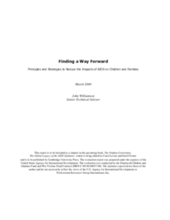Developing effective interventions to mitigate the devastation HIV/AIDS causes among children and families requires giving careful attention to both ends of the epidemic’s spectrum of impacts. It is vitally important to understand the problems on a human scale, what happens to parents, children, and orphans’ guardians. But this perspective, by itself, is not adequate to guide a strategic response to these problems. It is also essential to keep in mind the magnitude and scale of the HIV/AIDS pandemic and its collective impacts. Developing programs that significantly improve the lives of individual children and families affected by HIV/AIDS is relatively easy with enough resources, organizational capacity, and compassion. Vulnerable individuals and households can be identified, health services can be provided, school expenses of orphans can be paid, food can be distributed, and supportive counseling can be provided. Such interventions meet real needs, but the overwhelming majority of agencies and donors that have responded so far have paid too little attention to the massive scale of the problems that continue to increase with no end in sight. As programs to date have reached only a small fraction of the most vulnerable children in the countries hardest hit by AIDS, the fundamental challenge is to develop interventions that make a difference over the long haul in the lives of the children and families affected by HIV/AIDS at a scale that approaches the magnitude of their needs. Throughout this report, in keeping with the United Nations Convention on the Rights of the Child, the term “child” is used to refer to all persons below the legal age of majority: infants, children, and adolescents.
©USAID

